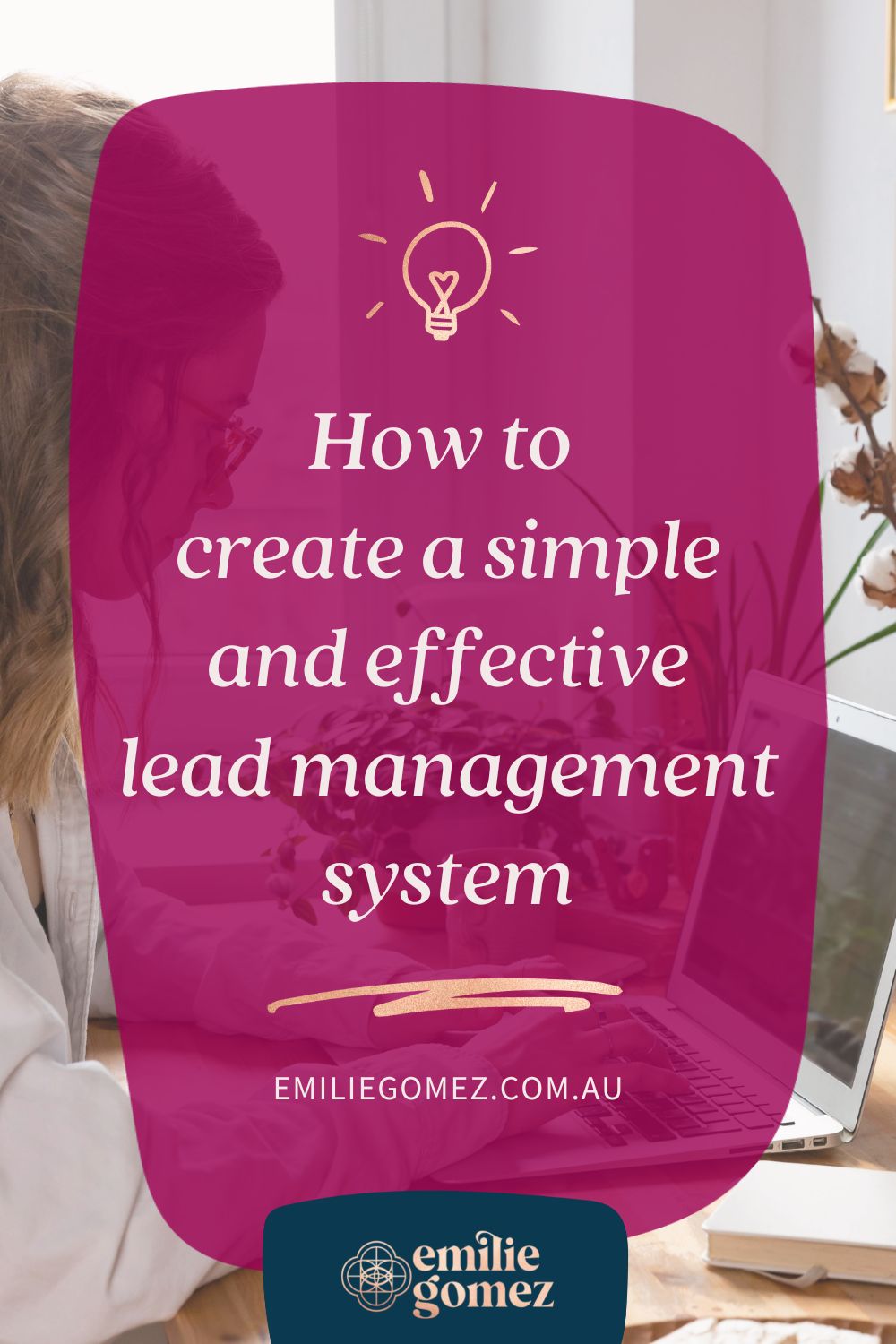This post contains affiliate links. If you sign up to an app using one of those links, I’ll get a small commission. I only recommend systems that I love and use in my business or with clients.
If you were to do a Google search right now for “lead management system”, here’s what you’d find. First, you’d see many ads about CRM (Customer Relationship Management) software. Then as you’d scroll down, you’d see a few articles from the same companies about what a lead management system is and the five (or more) parts you need.
You might feel exhausted and overwhelmed just by looking at those search results. They all sound very technical, with lots of sales and marketing jargon, and you can’t quite see how they apply to your business.
The truth is, if you’re a solopreneur, these articles and CRM software are most likely not for you. Although more tools and resources targeted at solopreneurs are available daily, they’re still overcomplicated and not suited for micro-businesses.
In this article, you’ll learn what a lead management system is and why you need one, even if your business is just you. You’ll discover the four parts you need to create a simple system to manage your leads effectively and ensure they turn into clients. Finally, you’ll learn what tools you can use – and the answer isn’t a CRM platform.
What’s a lead management system?
First, let’s define what a lead management system is.
Your lead management system (sometimes called presale system) encompasses all the activities you need to perform before a person says yes to working with you and becomes your client.
If you’re familiar with the levels of awareness (also called buyer’s journey), you’ll know that not everyone is on the same journey. Some people may have just discovered your social media profile and don’t even know they have a problem (awareness stage). In contrast, others are ready to buy (decision stage). But they’re all leads – they just need to hear different information from you.
As you’ll learn below, the tactics and how you manage each lead will also vary based on where they’re in your lead management process.
This may seem too complex, and you may wonder why you should bother with such a system.
Benefits of a lead management system
Simply put, your lack of a lead management system is costing you money.
If you don’t have a way for people to make enquiries easily or for you to follow up, then you’re missing out on opportunities, and that’s where you’re losing money.
You may have spent a great deal of energy on attracting the right clients, and you may even have ironed out all the kinks in your booking process. But then, you’re letting your potential client down by not being sufficiently prepared for your calls or not following up on time with leads who were ready to say yes.
An efficient lead management system not only helps keep you track of the who (i.e. who is a lead) but also tells you where they are on their purchasing journey and what they need from you next.
To help you define these next steps easily, let’s break down your lead management system into 4 simple stages.
The 4 stages of a simple lead management system
A lead management system consists of four main activities:

Let’s look at each one in detail.
#1 – Lead attraction
Lead attraction, also called lead generation, is about creating new potential clients for your business.
This is where your marketing and PR come in. You need to put yourself “out there” in the world so your ideal clients get to know you exist and how you can solve their problems.
Right now, the most common tactic in the online business world is to use social media to create awareness about you and what you offer. However, this can be done in other ways: SEO, networking, and PR.
How to measure your performance
To assess your lead attraction performance, you’ll want to look at:
- how many new views your social media profile or website gets
- how many new views your individual posts (social media, blog) or pages on your website get. This will tell you which posts work best. You can then analyse them to understand why – was it the content? Its length? Your copy? The images?
- how long your visitors stay on your website. This will tell you how well you’ve managed to capture your visitors’ attention, so they want to stick around.
#2 – Lead capture
Now that you’ve grabbed your lead’s attention, you need to get their information so you can reach out to them later to share more about you and how you can help them.
At this stage of your lead management system, you’ll need to consider:
- what information you need from your new lead
- where you’ll store this information
However, your answers to these questions may vary based on the lead capture type. There are different types of lead capture depending on where your potential client is on their journey with you (awareness, consideration, decision).
How to capture your leads
Awareness & Consideration stages
At this stage, your lead has just found you and wants to get to know you. They’ll most likely follow you on social media. You may not have their email address, but you can see and contact them via that platform.
However, I’m sure you’ve heard many times that you want to get your followers off social media so you can email them. This is to mitigate the risk of the platform disappearing or, more likely, your new lead deciding to leave social media to reclaim their time and mental health.
That’s where your “freebie” (or lead magnet) comes in. At this stage, you’ll only want to collect your new lead’s name and email address. People will be wary and unlikely to subscribe if you ask for more. This information will go into your email marketing system.
Decision stage
A lead here is someone who’s been following you for some time or understands how you can help them. They’re ready to book a call with you (and maybe even skipped the social media and freebie part).
You’ll be able to ask for more details using intake forms, as explained in this post about your booking process. This information will go into your booking system and help you qualify your leads, as described in the next section.
How to measure your performance
To assess your lead capture performance, you’ll want to track:
- How many new followers you get on your various social media profiles
- How many people subscribe to receive your lead magnets
- How many people booked discovery calls
However, you don’t want to look at those numbers independently as they won’t tell you much. You want to compare them to your lead attraction number above. For example, 1 new subscriber seems low. However, if you compare this to the number of people who landed on your lead magnet page, you’ll get a better picture.
Scenario 1
- Lead magnet page views: 2
- New subscribers: 1
- Conversion rate: 50%
→ you’re doing a great job at converting but not enough people are seeing your page. Focus on client attraction.
Scenario 2
- Lead magnet page views: 100
- New subscribers: 1
- Conversion rate: 1%
→ you’re doing a great job at attracting people but not converting them. Focus on your lead capture by reviewing your copy.
#3 – Lead qualification
Not all the leads you’ve attracted (#1) or captured (#2) are your ideal client. You need to review those leads and “qualify” them to ensure they’re a good fit and are likely to become a paying client. Hence the importance of knowing who you’re best-fit client is.
The qualification process can take many forms and depends on your business and offers. It’ll also be harder to assess a lead who’s early on their journey with you than someone who’s further along.
For example, you know nothing of the person who signs up for your freebie, apart from their email address. Using this, you may be able to find their website or their social media platforms, but it can prove quite time-consuming. On the other hand, you can find out more about someone who books a call with you using intake forms.
How to assess your leads
Some ways to evaluate your leads:
- 1-question survey in your welcome email sequence. Ask your new subscriber what they’re looking for by having clear choices (no more than 3) that will help you decide if they’re the right fit. For example, are they looking for DIY or done for you? Don’t be that blunt, though – make it fun and engaging!
- Applications and intake forms before discovery calls. Here’s your opportunity to learn more about them and ensure they’re the right fit. If you review their answers before they can book a call with you, you’ll need at least one specific question to help you accept or decline their application easily. For example, if you’re a Facebook Ad Manager who works with a minimum ad budget, you can ask your potential client what their budget is.
- Research before your discovery calls. Review your potential client’s answers to the intake form and check their website and social media profiles to learn more about them. Think about what they really need, how you can help them and the questions you need to ask them to know whether or not you’re a good fit.
- Discovery calls. Come prepared with the questions you need to ask to evaluate if they’re your ideal client. Contrary to common belief, this isn’t the time to solve their problems or demonstrate your coaching skills. You want to get to know each other so you can both decide if you’re a good fit.
What you discover during that phase will help you assess whether or not a lead is a good fit and how likely they’re to say yes to working with you. To help with this evaluation, most CRM platforms provide some sort of a scoring system, such as “cold”, “warm”, and “hot”. However, without clear guidelines and definitions of each category, this can become overwhelming and lead to procrastination.
During this phase, it’s easy to lose sight of the bigger picture and compromise your customer experience. You might focus too much on what you need from this process (i.e. understand if your lead is a best-fit client). As a result, you forget that this is also the time for your potential client to assess whether you’re right for them. A compromise could be asking fewer questions up-front, so your leads don’t feel intimidated, or being more explicit about who you work with so they can self-select.
How to measure your performance
You want to know how many of your leads were actually a good fit or became a client. Once again, instead of looking at this number in isolation, you’ll want to compare this number to your lead capture numbers to figure out your conversion rate.
#4 – Lead nurturing
Because not everyone will hire you right when they come across you, you’ll likely need to nurture them first. In other words, you must show your new lead that you understand them and can solve their problems.
How to nurture your leads
The information you need to share will vary depending on where they are on their buyer’s journey.
For example,
- If they’ve just signed up for your newsletter, you’ll want to send them a few emails (also known as a welcome sequence), so they know who you are and what you do. Once you’ve done that, you can share more about how to work with you.
- If they’ve booked a call with you, you’ll want to use the confirmation and reminder emails to explain what they can expect from the call so they feel prepared and at ease.
- If you’ve had a call, you’ll want to follow up with them promptly with an email to recap what was discussed and how you can help them. Even if they aren’t a good fit, a thank you email for their time and consideration will go a long way. You may not be suitable for them right then, but things could change, or their business friends may need you. I was looking for a coach recently, and one of the coaches I had a call with didn’t follow up (despite what they said during the call). We both knew we weren’t right for each other, but the lack of follow-through means it’s someone I won’t consider again. I’ve also shared my disappointment with friends who will likely not consider this coach.
What’s getting in your way
This step is often overlooked because:
- You assume your lead already has all the necessary information, and you don’t want to overload them with information or emails. Your potential client may already have what they need to make a decision. Still, you also want to make it easy for them to refer to this information. A well-written email that outlines things is never too much.
- You don’t want to appear salesy or pushy. Your lead is a lead because they showed some interest in working with you. It’s your role to provide more information so they can make an educated decision. You can share about your offerings without being salesy or pushy.
- You feel overwhelmed by everything you need to do and all the emails you have to write – or the Bonjoro you have to record. You don’t know what to say or where to start. Let’s reframe this: your welcome sequence is something you only have to do once (and update as needed). For your call follow-up emails, consider having a template you personalise as needed.
- You focus too much on the first part of their funnel, i.e. client attraction. Of course, you need new leads. However, many entrepreneurs spend too much time in this phase and not enough time nurturing their existing or past clients with whom they already have a relationship. Remember, it’s easier to keep a current client than to convert a new one since they don’t know you. Be mindful of this and ensure that where you spend most of your time is aligned with your strategy and your business needs.
How to measure your performance
To measure the effectiveness of your nurturing emails, you’ll want to track:
- How many emails it takes for someone to say yes or book a call
- The type of emails and copy that leads to sales or discovery calls
- Your click-rate
Do you need a CRM tool to manage your leads?
Some platforms will cover your entire process (e.g. Kartra, Keap), while others will only do parts (e.g. Ontraport doesn’t do appointment scheduling, and Dubsado doesn’t do email marketing). Unfortunately, many of these platforms call themselves CRM tools despite covering only one part of the process. This makes it confusing and challenging to select the right tool for your business.
If you don’t need all the bells and whistles of an all-in-one tool, you can opt for platforms that each focus on one area of your process (e.g. MailerLite for email marketing, Acuity Scheduling for bookings). Specialised platforms will likely have more advanced features available. However, having multiple platforms makes your business more complex and can become expensive. Plus, you’ll probably need to add an integration platform such as Zapier or Make to keep all your tools in sync.
How to decide which tools you need
Before you decide on a tool, make sure you know what your process is and what tasks you need to complete at every stage.
You’ll also want to answer the following questions:
- What is your goal for this platform?
- What are you trying to achieve?
- Why do you think you need a tool? What problem will it solve?
- Can any of your other applications help?
- Do you need better automation and integration?
A simple lead management system takes people on a journey: from the moment they meet you (attraction), to when they want to know you (capture), to when you assess if they’re a good fit (qualification), to helping them decide to hire you or not (nurturing), to becoming a client.
Each stage has its own set of tactics and metrics. These will vary based on your potential client’s level of awareness, i.e. how much they already know about the problem you solve and your unique solution. Understanding these nuances will help you decide on the tools you’ll need. You may not need a full-blown CRM platform, but you’ll likely need some tools, such as an email marketing platform and an appointment scheduler.
Defining your lead management system may seem complex. But it’s an exercise worth doing. An efficient system will support you in generating new leads regularly and converting them to paying clients.If you need help creating your lead management process and deciding on a tool, check out Your Profitable + Scalable System Toolkit. The toolkit will teach you the exact steps to create systems that will allow you to scale your business.













